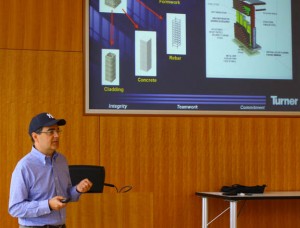By Geoff Gehman ’80

John Pierce '81 describes building information modeling.
John Pierce ’81 was the only 2011 Reunion College speaker who wore a New York Yankees hat. The cap was a prop during his Skillman Library presentation on how his employer, Turner Construction Company, used 3-D modeling to manage the building of the new Yankee Stadium, the $2.3 billion successor to the old Yankee Stadium, one of the world’s most famous sports facilities.
Pierce didn’t actually work on the New York Yankees’ latest home, which opened in 2009 next door to the team’s original Bronx home in use from 1923 to 2008. But the Turner vice president knows all about Building Information Modeling (BIM), a system of virtual prototypes that has revolutionized preparations for the construction of radical structures. Turner, for example, used BIM to monitor the erection of a 50-story bank tower in Mexico City, a project supervised by Pierce in his role as the company’s Latin America manager.
According to Pierce, Turner draftsmen tested the preconstruction of the new Yankee Stadium in a design laboratory/command center. The specialists consulted remarkably detailed color-coded pictures of every element: pipes to bolts, lighting fixtures to elevators, a replica of the old Yankee Stadium’s field dimensions to a facsimile of the former ballpark’s fabled façade frieze. Blue bands, for example, signified the electronic signs that ring the new Yankee Stadium, part of a $200 million audio-visual system. The bands were used to ensure that every spectator could see every animation clearly, from player statistics to the words of “The Star-Spangled Banner.”
Pierce revealed that BIM detected a whopping 18,000 structural conflicts before construction began on the new Yankee Stadium. Virtual prototypes, he pointed out, reduced building costs by 5 percent and saved countless redesign headaches. “In the old days we would be fixing things with our erasers,” he says, “and maybe we would have caught half of those clashes.”
Pierce is a veteran member of the Turner-Lafayette team. Turner hired him shortly after he received a B.S. in civil engineering. He is one of 40 Lafayette graduates who work for the company, which has built or renovated dozens of sports facilities, including Wrigley Field, the hallowed home of the Chicago Cubs. Lafayette students have shadowed him at Turner, which helped rebuild Pardee Hall and Skillman Library. His externships extend the educational mission of his colleagues who coach aspiring engineers at high schools in metropolitan New York as part of Turner’s Yankee Stadium outreach program.
Pierce’s audience at Skillman included one ringer: Jeff Kline, the New York Yankees’ head of ticket accounting. He was invited to the presentation by his brother, Mike Kline ’76, who graduated shortly after Yankee Stadium reopened after a two-year renovation.
Jeff Kline’s manner was as lively as his plaid shorts. He inquired about the cement used in the new Yankee Stadium, his curiosity aroused by growing up in Phillipsburg, N.J., near cement houses built from designs by Thomas Edison. He questioned the infallibility of BIM, pointing out that the system couldn’t prevent his stadium office from being placed above a drafty gate, which in the winter turns his floor into a freezing tundra.
Pierce responds with a smile and a shrug. “BIM picked up 18,000 clashes; there are 18,001 now,” he says. “It’s not yet a perfect world.”
Kline didn’t mention the most notorious structural glitch at the new Yankee Stadium: seats with obstructed views. He did mention the Boston Red Sox jersey buried under two feet of concrete by a Sox fan, a freelance construction worker who wanted to hex the Yankees, Boston’s archrival. Pierce mentions that in fact a construction friend of his discovered the voodoo talisman, which was removed after an extremely expensive excavation and donated to a Boston charity, which auctioned it for $175,100.
The entombment of the Sox jersey led Ed Auble ’61 to wonder aloud if the new Yankee Stadium was the final resting place for the long-missing body of Teamsters boss Jimmy Hoffa, still rumored to rest under the old Giants Stadium, the former home of the New York Giants, who once played at the old Yankee Stadium. “No,” jokes Pierce, “he’s pre-BIM.”
